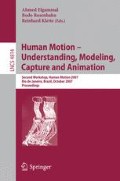Abstract
This paper presents an approach for human detection and simultaneous behavior recognition from images and image sequences. An action representation is derived by applying a clustering algorithm to sequences of Histogram of Oriented Gradient (HOG) descriptors of human motion images. For novel image sequences, we first detect the human by matching extracted descriptors with the prototypical action primitives. Given a sequence of assigned action primitives, we can build a histogram from observed motion. Thus, behavior can be classified by means of histogram comparison, interpreting behavior recognition as a problem of statistical sequence analysis. Results on publicly available benchmark-data show a high accuracy for action recognition.
Access this chapter
Tax calculation will be finalised at checkout
Purchases are for personal use only
Preview
Unable to display preview. Download preview PDF.
References
Thurau, C., Hlaváč, V.: n-grams of Action Primitives for Recognizing Human Behavior. In: CAIP 2007. The 12th International Conference on Computer Analysis of Images and Patterns, Springer, Heidelberg (2007)
Blank, M., Gorelick, L., Shechtman, E., Irani, M., Basri, R.: Actions as Space-Time Shapes. In: Tenth IEEE International Conference on Computer Vision, IEEE Computer Society Press, Los Alamitos (2005)
Niebles, J.C., Fei-Fei, L.: A Hierarchical Model of Shape and Appearance for Human Action Classification. In: CVPR 2007. IEEE Computer Society Conference on Computer Vision and Pattern Recognition, IEEE Computer Society Press, Los Alamitos (2007)
Dalal, N., Triggs, B.: Histograms of Oriented Gradients for Human Detection. In: CVPR 2005. 2005 IEEE Computer Society Conference on Computer Vision and Pattern Recognition, IEEE Computer Society Press, Los Alamitos (2005)
Thurau, C., Bauckhage, C., Sagerer, G.: Synthesizing Movements for Computer Game Characters. In: Rasmussen, C.E., Bülthoff, H.H., Schölkopf, B., Giese, M.A. (eds.) DAGM 2004. LNCS, vol. 3175, pp. 179–186. Springer, Heidelberg (2004)
Schack, T., Mechsner, F.: Representation of motor skills in human long-term memory. Neuroscience Letters 391, 77–81 (2006)
Niebles, J.C., Wang, H., Fei-Fei, L.: Unsupervised Learning of Human Action Categories Using Spatial-Temporal Words. In: BMVC 2006. British Machine Vision Conference (2006)
Lu, W.L., Little, J.J.: Simultaneous tracking and action recognition using the pca-hog descriptor. In: CRV 2006. The Third Canadian Conference on Computer and Robot Vision (2006)
Ghahramani, Z.: Building blocks of movement. Nature 407, 682–683 (2000)
Wolpert, D.M., Ghahramani, Z., Flanagan, J.R.: Perspectives and problems in motor learning. TRENDS in Cognitive Sciences 5(11), 487–494 (2001)
Krüger, V., Kragic, D., Ude, A., Geib, C.: Meaning of action (2007)
Thoroughman, K., Shadmehr, R.: Learning of action through adaptive combination of motor primitives. Nature 407, 742–747 (2000)
Fod, A., Matarić, M., Jenkins, O.: Automated Derivation of Primitives for Movement Classification. Autonomous Robots 12(1), 39–54 (2002)
Lee, C.S., Elgammal, A.: Human motion synthesis by motion manifold learning and motion primitive segmentation. In: Perales, F.J., Fisher, R.B. (eds.) AMDO 2006. LNCS, vol. 4069, pp. 464–473. Springer, Heidelberg (2006)
Moeslund, T., Reng, L., Granum, E.: Finding Motion Primitives in Human Body Gestures. In: Gibet, S., Courty, N., Kamp, J.F. (eds.) GW 2005. LNCS (LNAI), vol. 3881, pp. 133–144. Springer, Heidelberg (2006)
Moeslund, T., Fihl, P., Holte, M.: Action Recognition using Motion Primitives. In: The 15th Danish conference on pattern recognition and image analysis (2006)
Ogale, A.S., Karapurkar, A., Aloimonos, Y.: View-invariant modeling and recognition of human actions using grammars. In: ICCV Workshop on Dynamical Vision (2005)
Guerra-Filho, G., Aloimonos, Y.: A Sensory-Motor Language for Human Activity Understanding. In: HUMANOIDS 2006. 6th IEEE-RAS International Conference on Humanoid Robots, pp. 69–75. IEEE Computer Society Press, Los Alamitos (2006)
Hamid, R., Johnson, A., Batta, S., Bobick, A., Isbell, C., Coleman, G.: Detection and Explanation of Anomalous Activities: Representing Activities as Bags of Event n-Grams. In: CVPR 2005. 2005 IEEE Computer Society Conference on Computer Vision and Pattern Recognition, IEEE Computer Society Press, Los Alamitos (2005)
Goldenberg, R., Kimmel, R., Rivlin, E., Rudzsky, M.: Behavior classification by eigendecomposition of periodic motions. Pattern Recognition 38, 1033–1043 (2005)
Lowe, D.: Distinctive image features from scale-invariant keypoints. International Journal of Computer Vision 20, 91–110 (2003)
Schroff, F., Criminisi, A., Zisserman, A.: Single-Histogram Class Models for Image Segmentation. In: Proceedings of the Indian Conference on Computer Vision, Graphics and Image Processing (2006)
Porikli, F.: Integral histogram: A fast way to extract higtograms in cartesian spaces. In: CVPR. IEEE Computer Society Conference on Computer Vision and Pattern Recognition, pp. 829–836. IEEE Computer Society Press, Los Alamitos (2005)
Zhu, Q., Avidan, S., Yeh, M., Cheng, K.: Fast Human Detection Using a Cascade of Histograms of Oriented Gradients. In: IEEE Computer Society Conference on Computer vision and Pattern Recognition, pp. 1491–1498. IEEE Computer Society Press, Los Alamitos (2006)
Dalal, N., Triggs, B., Schmid, C.: Human detection using oriented histograms of flow and appearance. In: European Conference on Computer Vision (2006)
Author information
Authors and Affiliations
Editor information
Rights and permissions
Copyright information
© 2007 Springer-Verlag Berlin Heidelberg
About this paper
Cite this paper
Thurau, C. (2007). Behavior Histograms for Action Recognition and Human Detection. In: Elgammal, A., Rosenhahn, B., Klette, R. (eds) Human Motion – Understanding, Modeling, Capture and Animation. HuMo 2007. Lecture Notes in Computer Science, vol 4814. Springer, Berlin, Heidelberg. https://doi.org/10.1007/978-3-540-75703-0_21
Download citation
DOI: https://doi.org/10.1007/978-3-540-75703-0_21
Publisher Name: Springer, Berlin, Heidelberg
Print ISBN: 978-3-540-75702-3
Online ISBN: 978-3-540-75703-0
eBook Packages: Computer ScienceComputer Science (R0)

